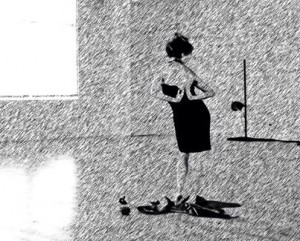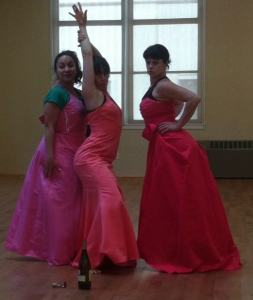Live Arts Fest Features New Dance Companies from SD and SF
Jean Isaacs has clearly cloned herself. How could any one person maintain Isaacs’ output of work for San Diego Dance Theater, direct her school, manage the White Box Theater at Liberty Station … and make the White Box one of the go-to dance/performance venues in town? The low-tech space is the site of another Isaacs venture, the Live Arts Festival. Year 2 of the festival took place April 15-27 and featured nine dance performances and an evening of avant-garde puppetry. Highlights included the local debut of San Francisco-based Vîv and the premiere of a new San Diego company, Push Process, directed by Lavina Rich.
 Vîv formed last year with the intention of rethinking the processes of training, making dances, and creating community. There’s a strong sense of investigating movement and developing connections among dancers in the work they showed here. In “Escape is Impossible,” a duet by Alison Williams, Virginia Broyles and Alex Crow play with crossing the space diagonally, advancing a few wobbly steps and then jerking back as if they’ve hit a wall. In what feels like a strained conversation, set to Zoe Keating’s digitally-enhanced cello, they sometimes support each other in a desperate embrace. In “Ouroboros(6)” by Kathleen Hermesdorf (a veteran San Francisco dance artist who’s not a Vîv member), six dancers explore movements that suggest the Ouroboros, the mythical snake that eats its own tail: linear formations break apart and then reform, and there’s an undulating walk – a step followed by a hip circle – done in unison.
Vîv formed last year with the intention of rethinking the processes of training, making dances, and creating community. There’s a strong sense of investigating movement and developing connections among dancers in the work they showed here. In “Escape is Impossible,” a duet by Alison Williams, Virginia Broyles and Alex Crow play with crossing the space diagonally, advancing a few wobbly steps and then jerking back as if they’ve hit a wall. In what feels like a strained conversation, set to Zoe Keating’s digitally-enhanced cello, they sometimes support each other in a desperate embrace. In “Ouroboros(6)” by Kathleen Hermesdorf (a veteran San Francisco dance artist who’s not a Vîv member), six dancers explore movements that suggest the Ouroboros, the mythical snake that eats its own tail: linear formations break apart and then reform, and there’s an undulating walk – a step followed by a hip circle – done in unison.
The downside of focusing on process is that work may look too much like movement exercises, and that’s something of a problem with these pieces and a solo by Hallie Dalsimer. The one exception is “Hysterical Young Woman,” Sam Stone’s solo in which she plays a sort of nightclub emcee with terrific physical humor – struggling to zip a slinky black dress, standing on a piece of satiny red fabric and moving across the stage by shifting her feet so the fabric slides with her. She’s all angles, doing a jerky dance like a broken mechanical doll or leaning forward, one hip jutting, as she trills “Welcome.” Process is crucial for the studio, but I loved seeing Stone’s guts and grit onstage.
Lavina Rich has shown work around town for a while, but her full-evening Live Arts show was the debut of her Push Process company. Rich can be hilarious and camp, yet there’s a deep-down seriousness, and the strongest of the works she showed, “Broken Women,” has stuck with me.
 “Broken Women” opens with Jessica Curiel, Maria Juan, and Molly Puryear in red and pink evening gowns, glamorous as all get out, except they’re having a bitch of a time zipping the dresses. (They and Stone must shop at the same irregulars store.) They act increasingly crazed – Puryear lies on her stomach talking to herself, and Curiel and Juan go into contortions trying to get those zippers – and they’re quite interested in a bottle of wine. In a solo, Cecily Freeman-Holcombe seems a genteel lady, but her tea-party dress is torn, and her graceful winglike moves sometimes give way to twitching as if her body is covered by ants. Rich and Beth Calarco lack the other women’s sophisticated clothes, they just wear faded cotton dresses; however, as they come forward side by side, at first shyly and then with more confidence, and get silly together – Rich doing tap-dance shuffles and both pushing up their breasts like kids wondering if they’ll ever develop – they have each other, and, unlike the women in the earlier sections, they’re strong.
“Broken Women” opens with Jessica Curiel, Maria Juan, and Molly Puryear in red and pink evening gowns, glamorous as all get out, except they’re having a bitch of a time zipping the dresses. (They and Stone must shop at the same irregulars store.) They act increasingly crazed – Puryear lies on her stomach talking to herself, and Curiel and Juan go into contortions trying to get those zippers – and they’re quite interested in a bottle of wine. In a solo, Cecily Freeman-Holcombe seems a genteel lady, but her tea-party dress is torn, and her graceful winglike moves sometimes give way to twitching as if her body is covered by ants. Rich and Beth Calarco lack the other women’s sophisticated clothes, they just wear faded cotton dresses; however, as they come forward side by side, at first shyly and then with more confidence, and get silly together – Rich doing tap-dance shuffles and both pushing up their breasts like kids wondering if they’ll ever develop – they have each other, and, unlike the women in the earlier sections, they’re strong.
Something I love about this piece is the spot-on girliness of Curiel, Juan, and Puryear, and then Rich and Calarco, conferring with each other, whispering as if discussing what to do next.
The dancers may also be having private chats in “Universal,” when they slouch on a sofa turned away from the audience. Set to songs by Motown great Marvin Gaye – and presumably inspired by Gaye’s life – “Universal” has a leering man (Anthony Rodriguez) with a lot of women seductively hanging around him; Juan is especially striking in flirty, jazzy moves done with clarity and power. This ultra-camp piece features lots of vamping, big white feather fans, and additional feathers that end up all over the floor. At one point, when there’s video (by Juan) with images of crosses and bondage, and dancers are writhing on the floor, I wrote, “Kind of a mess.” And yet here, as in “Broken Women,” I’m intrigued by Rich’s deconstruction of glamour and her instincts for composition, the way she places dancers in the space. Even when this piece is messy, I sense a complex intelligence behind it all.
A third piece, “Designing the Process,” has some nicely composed clusters of dancers and contrasts between movement and freezes, but feels more like a work in process.
So, there’s room for growth with Vîv and Push Process. And lots of promise.
Correction: The name of the San Francisco group is Vîv, rather than The Women of Vîv, as stated in the Live Arts publicity and program. This review has been changed to use the correct name.

Award-winning dance journalist Janice Steinberg has published more than 400 articles in the San Diego Union-Tribune, Dance Magazine, the Los Angeles Times, and elsewhere. She was a 2004 New York Times-National Endowment for the Arts fellow at the Institute for Dance Criticism and has taught dance criticism at San Diego State University. She is also a novelist, author of The Tin Horse (Random House, 2013). For why she’s passionate about dance, see this article on her web site, The Tin Horse
